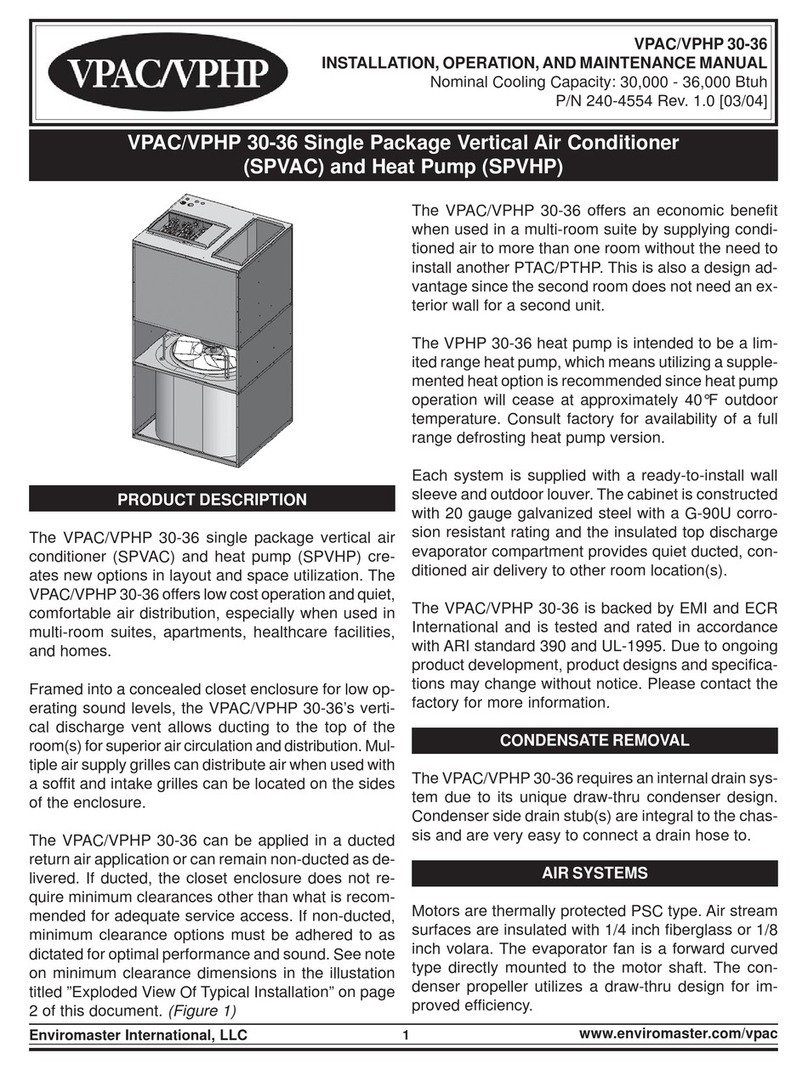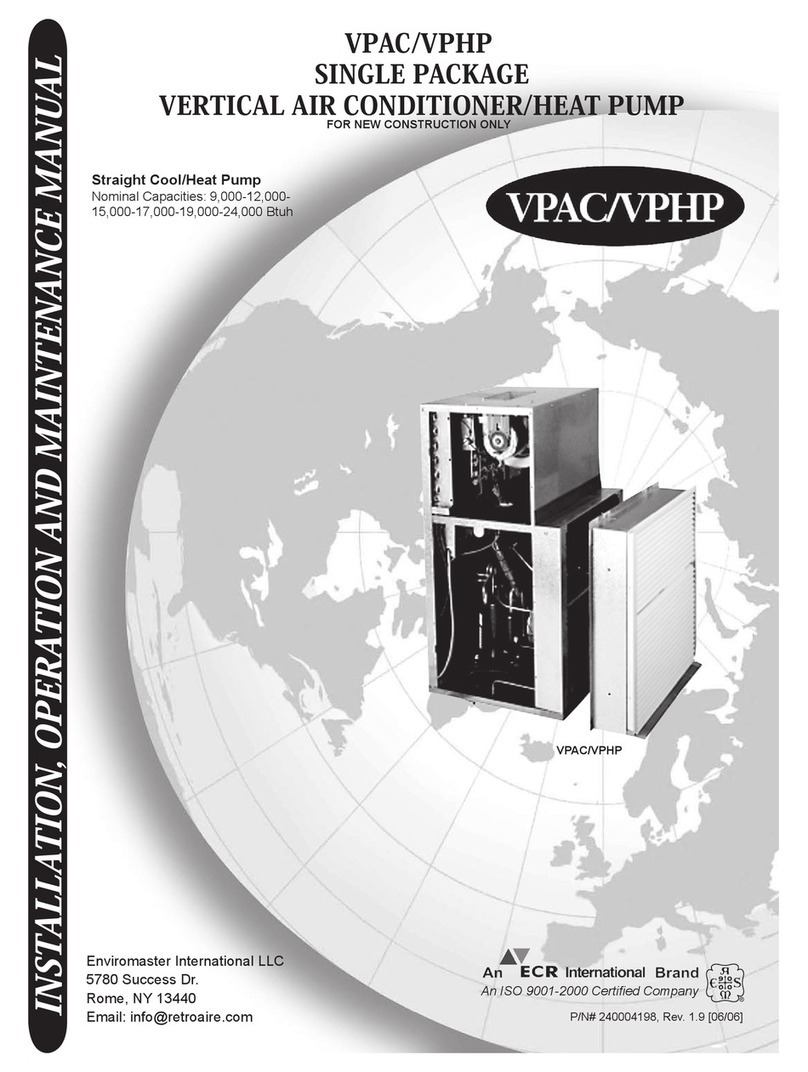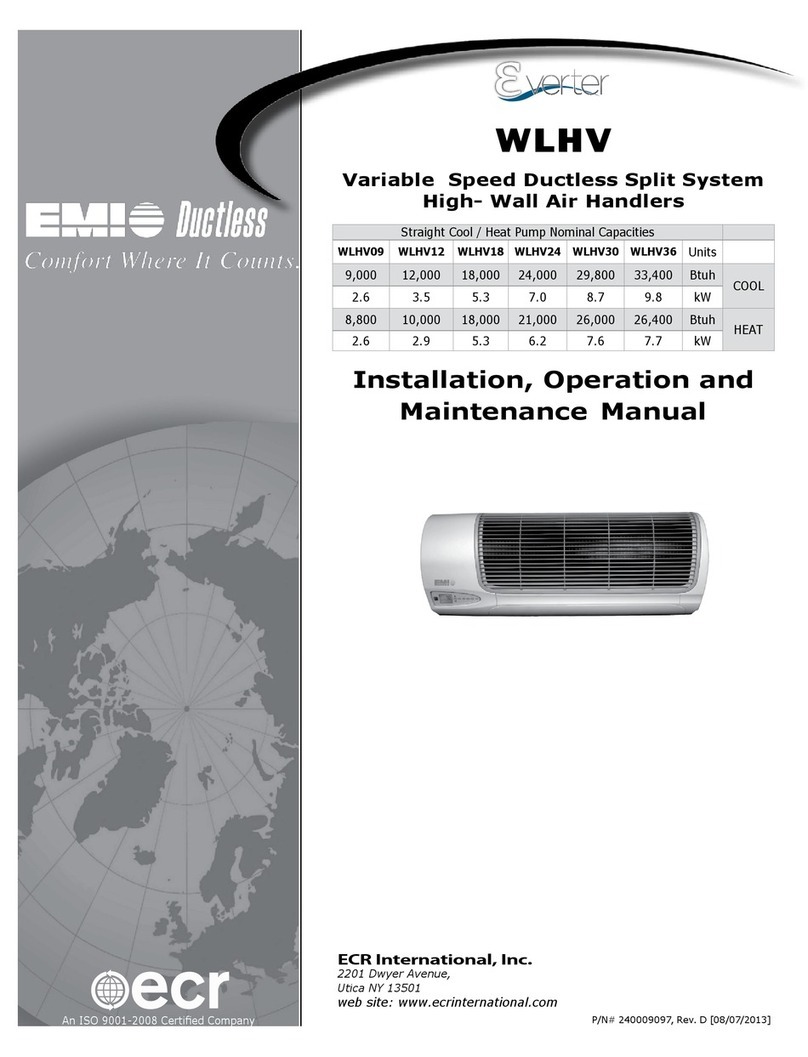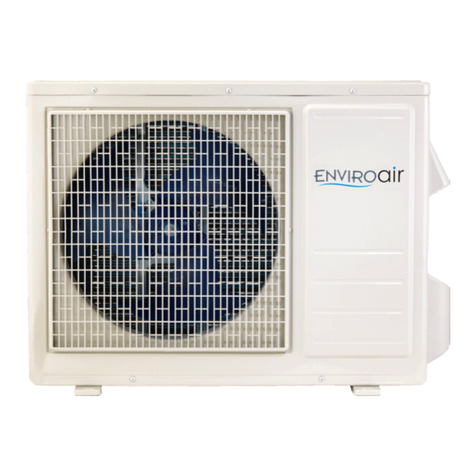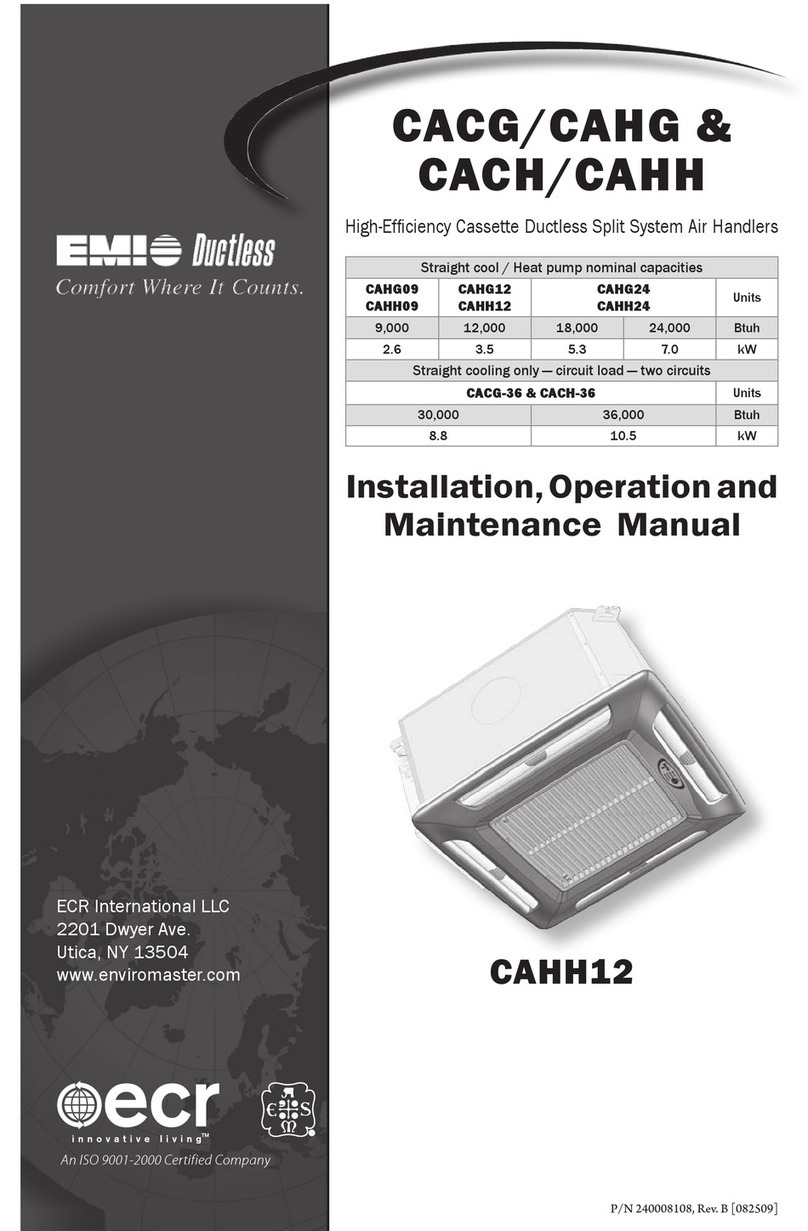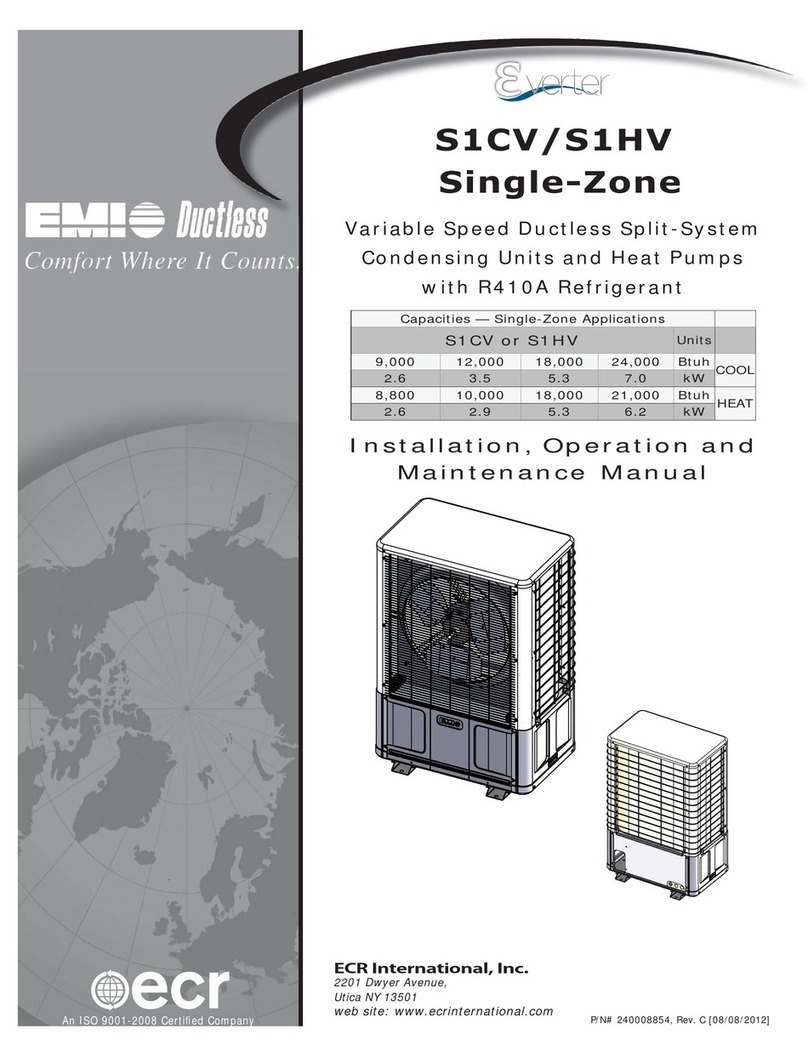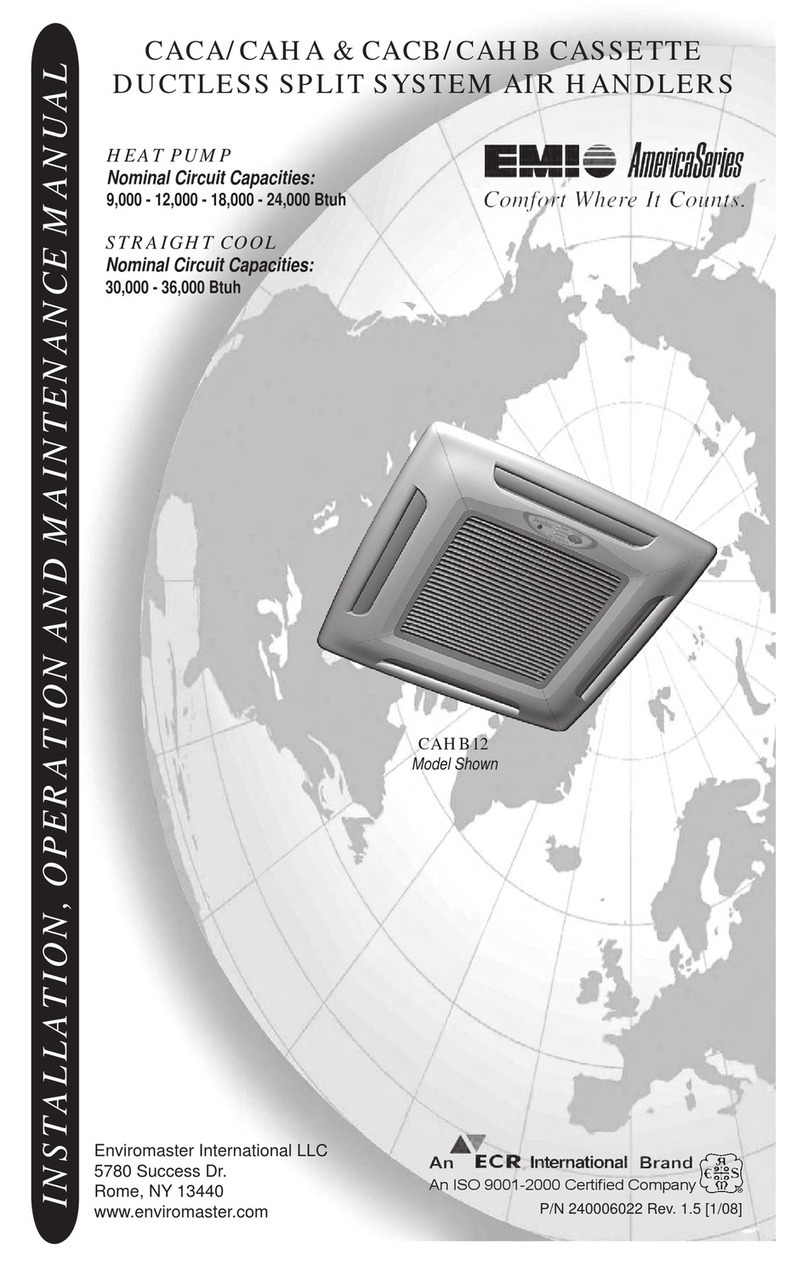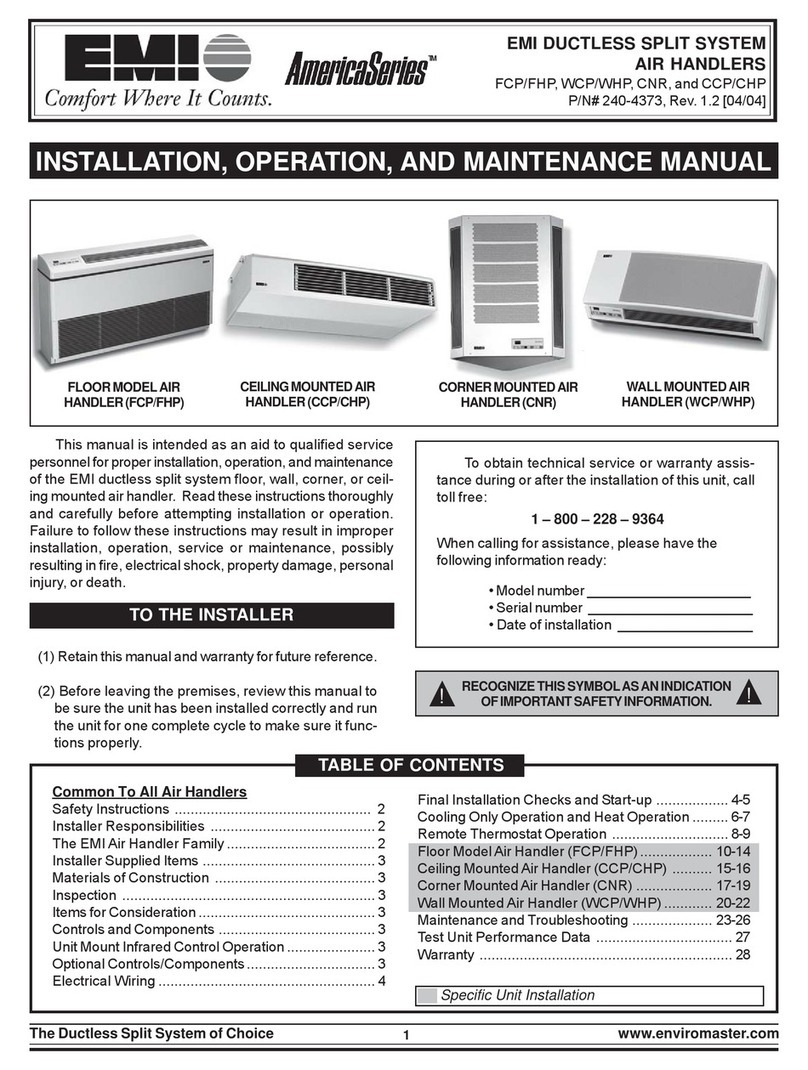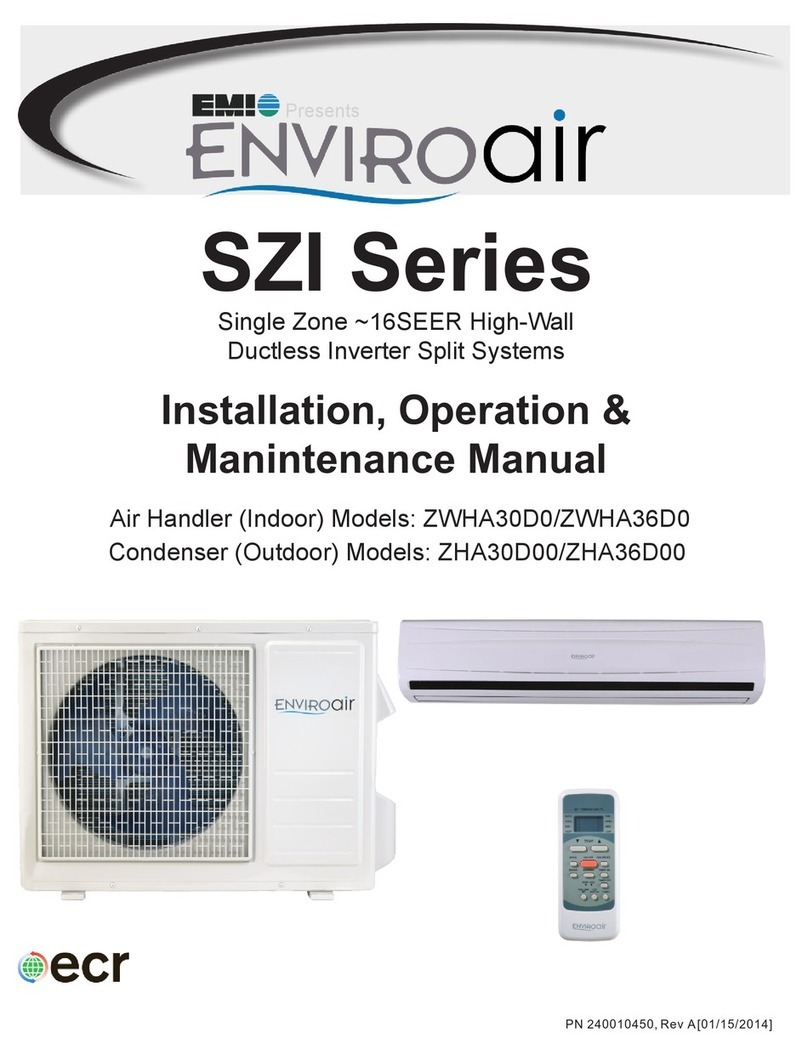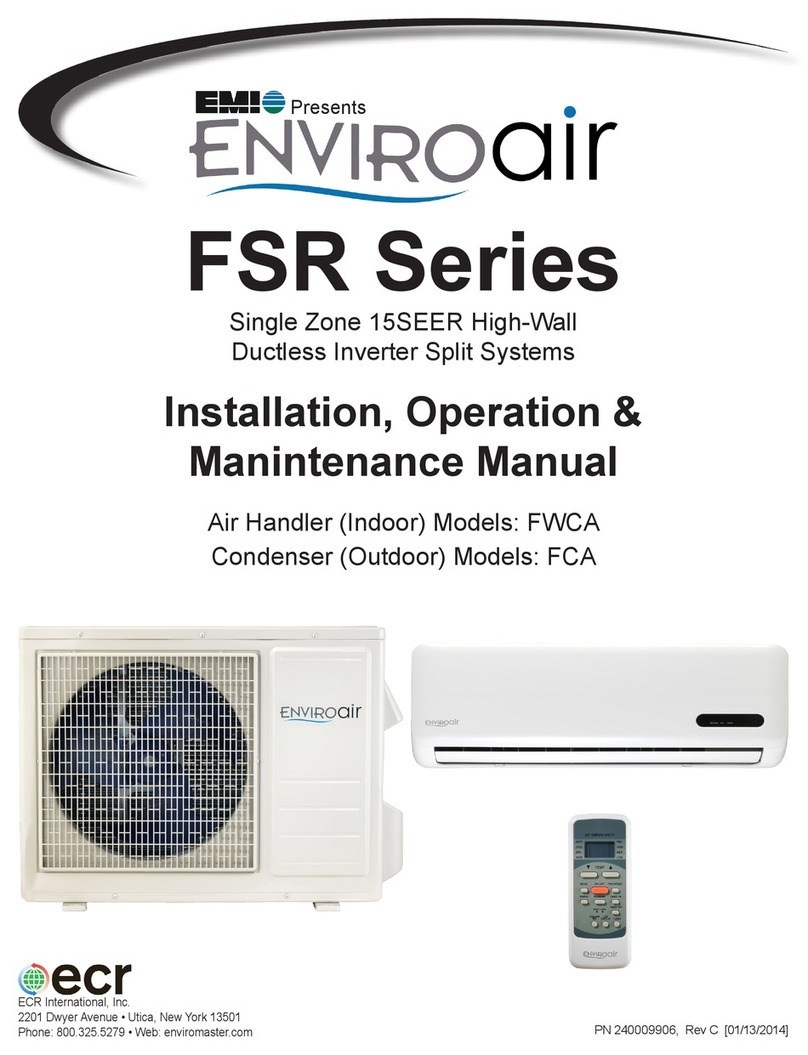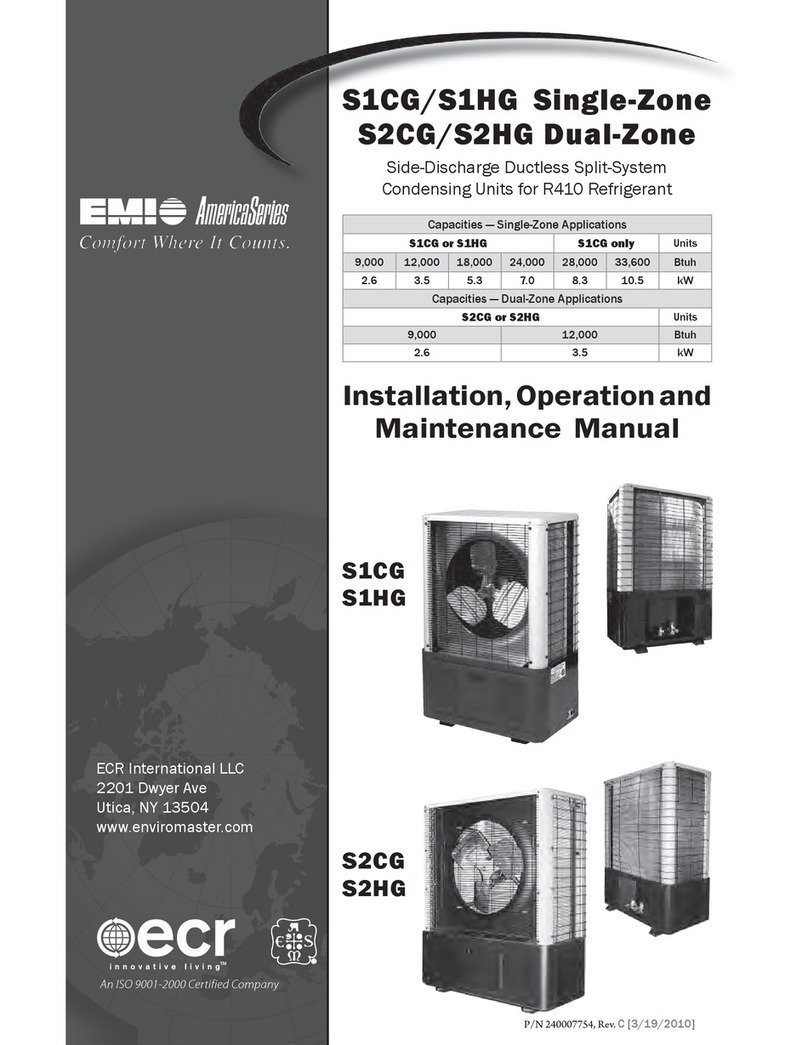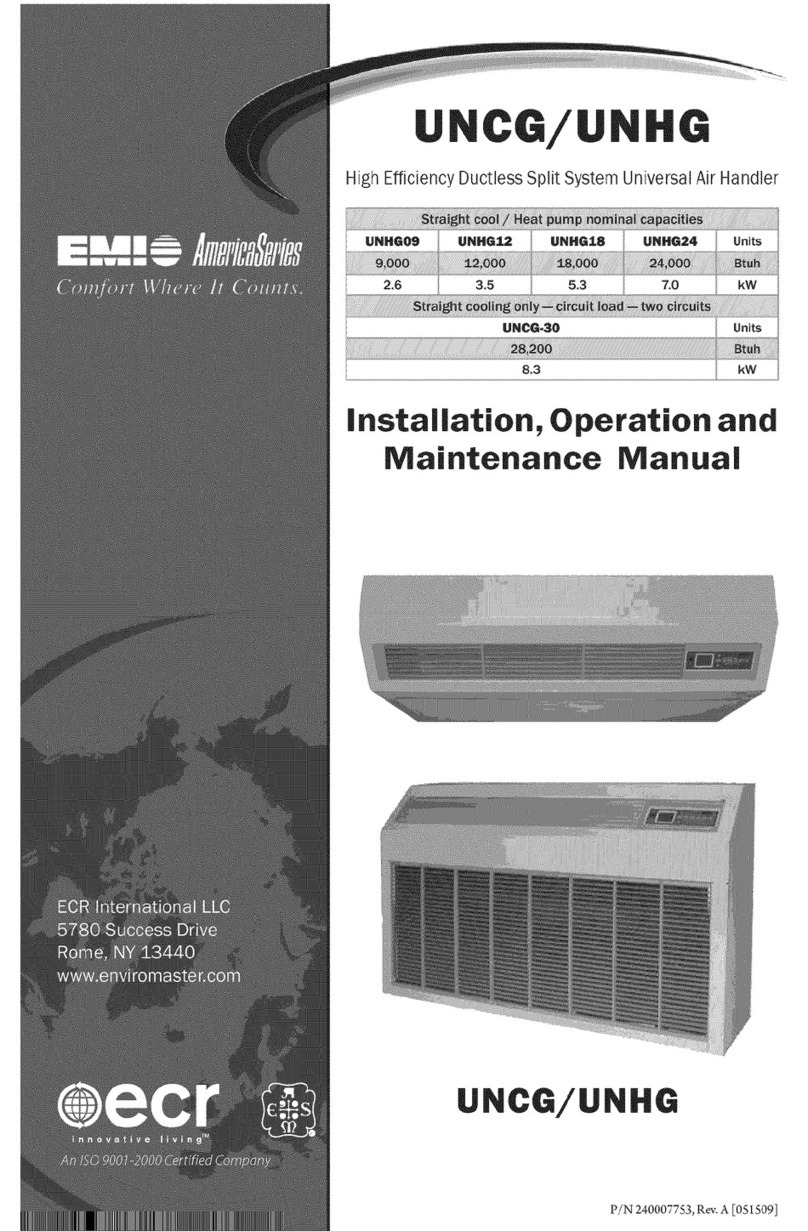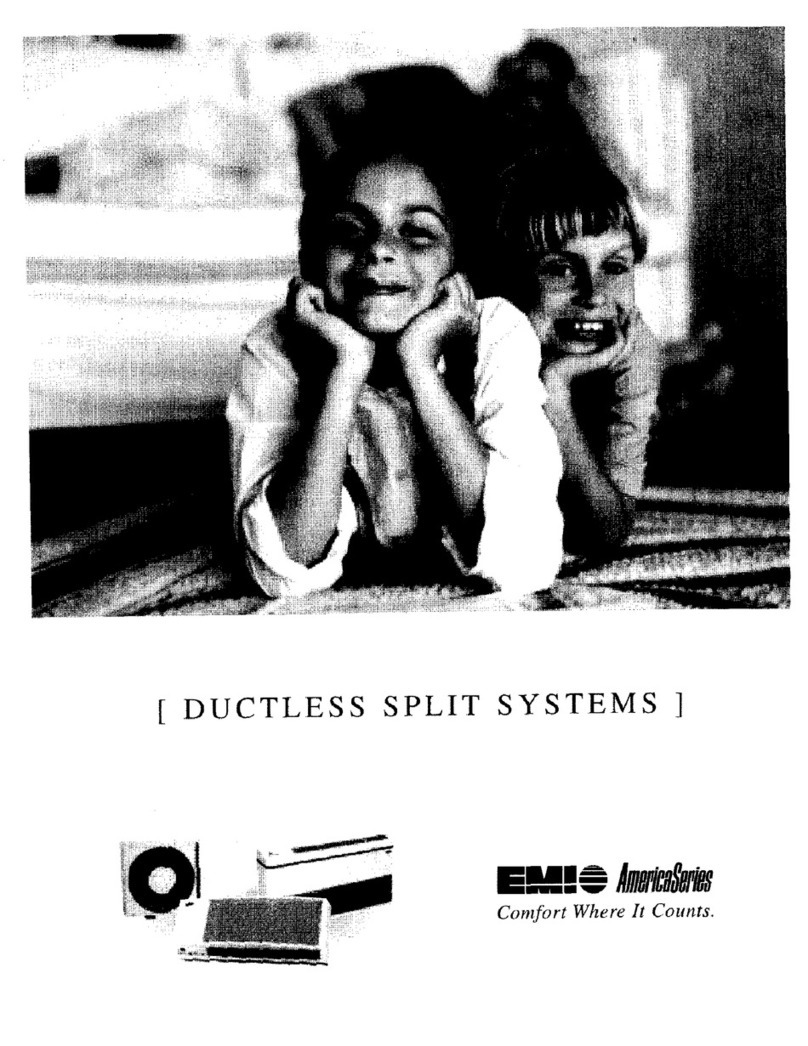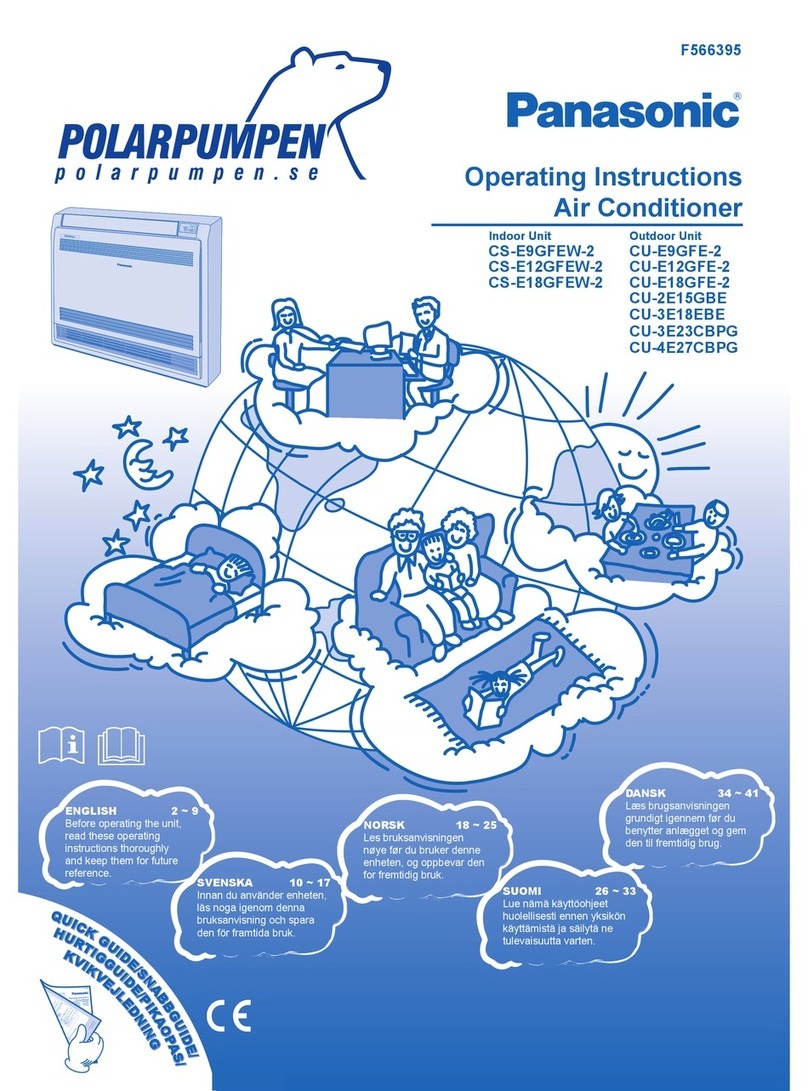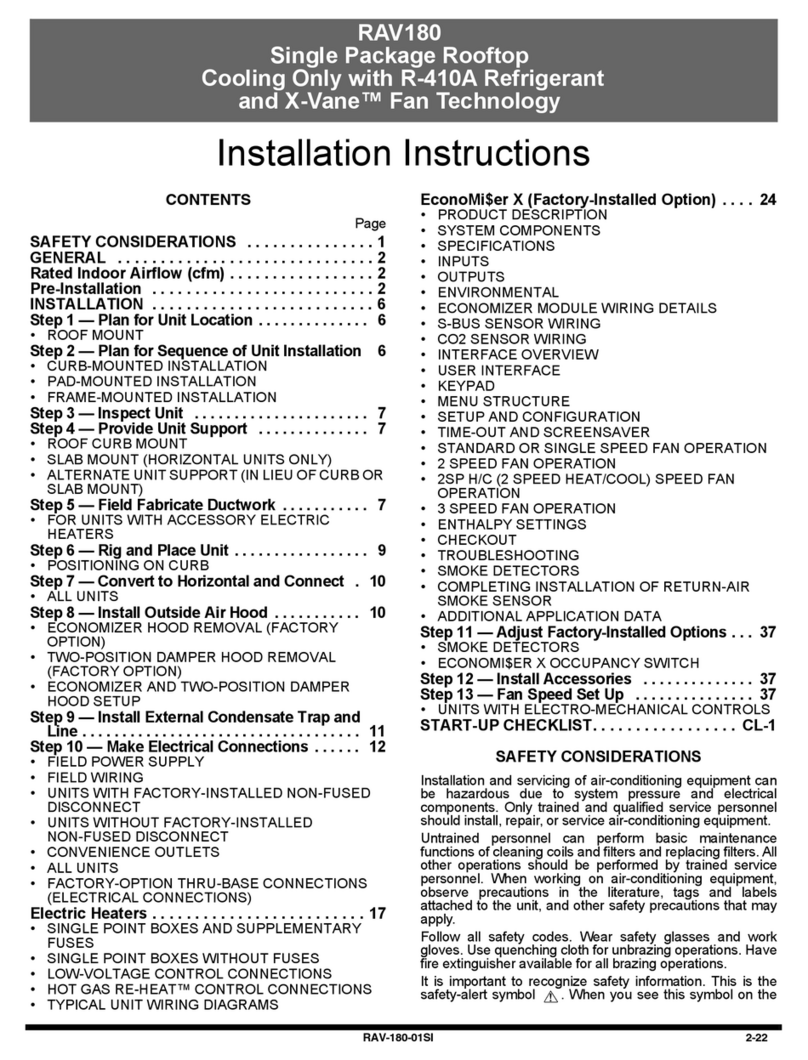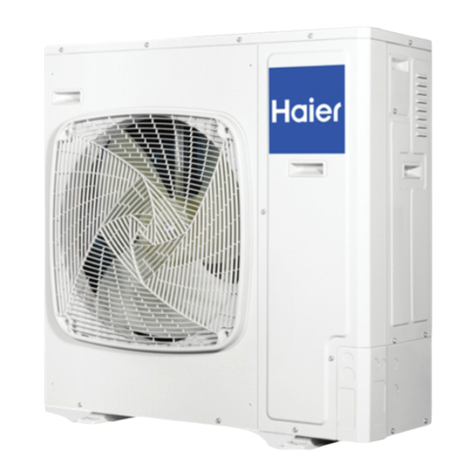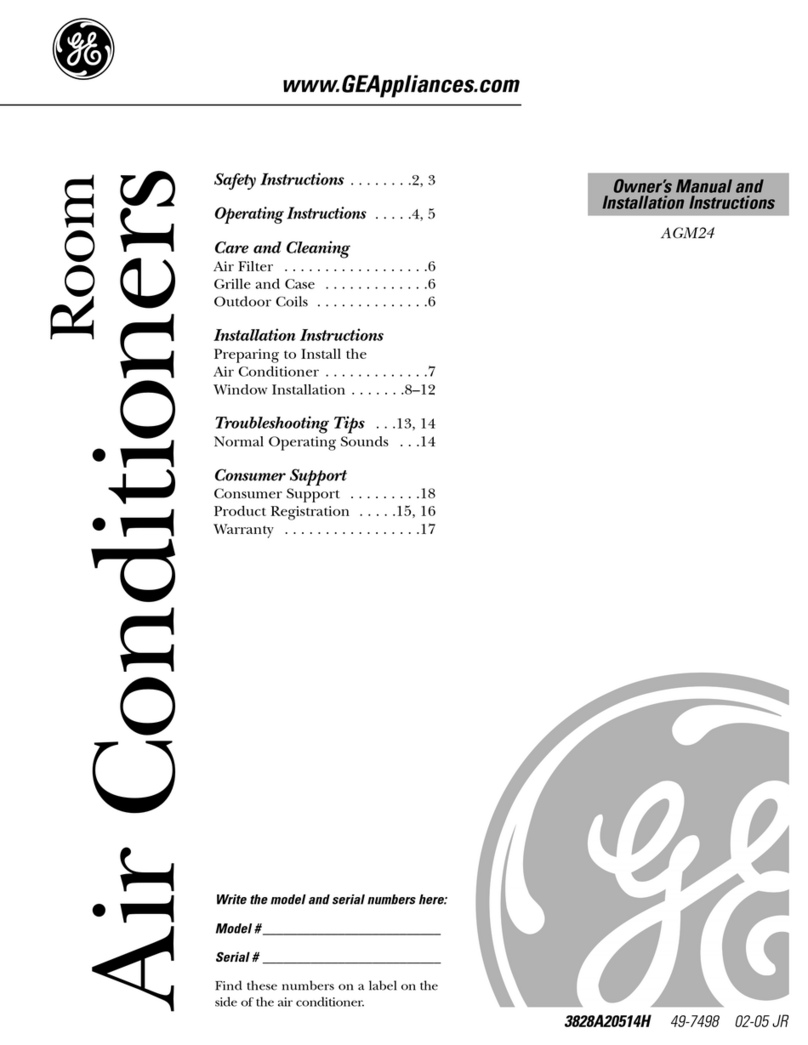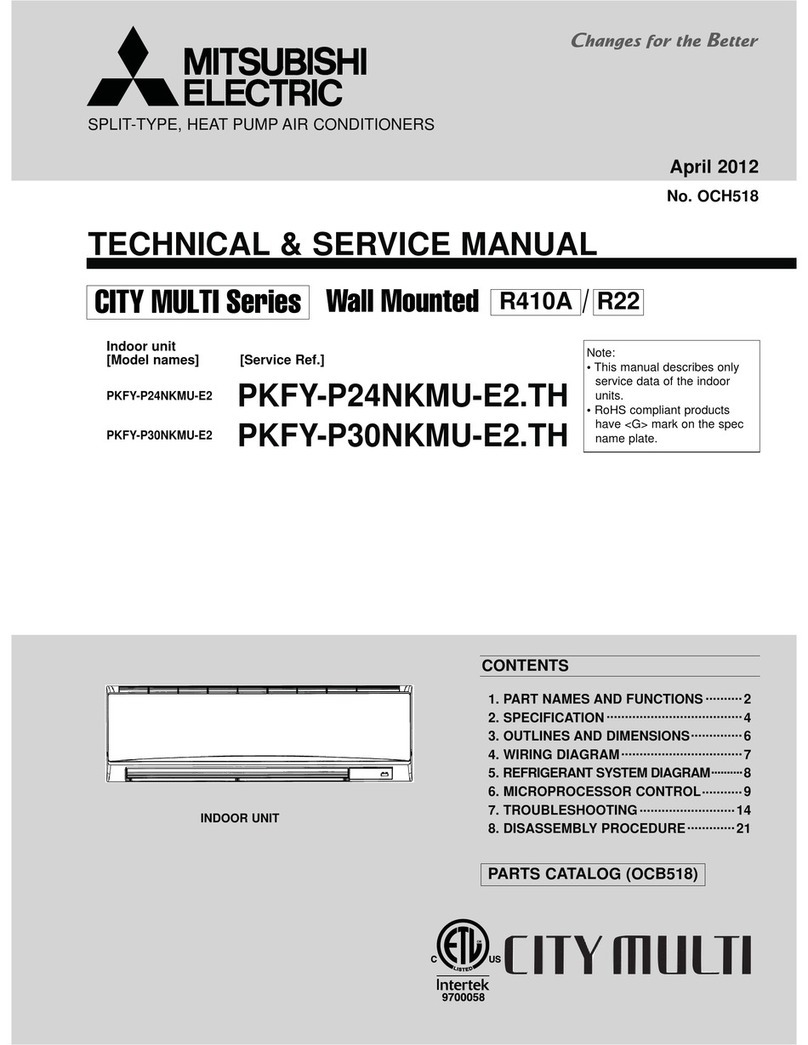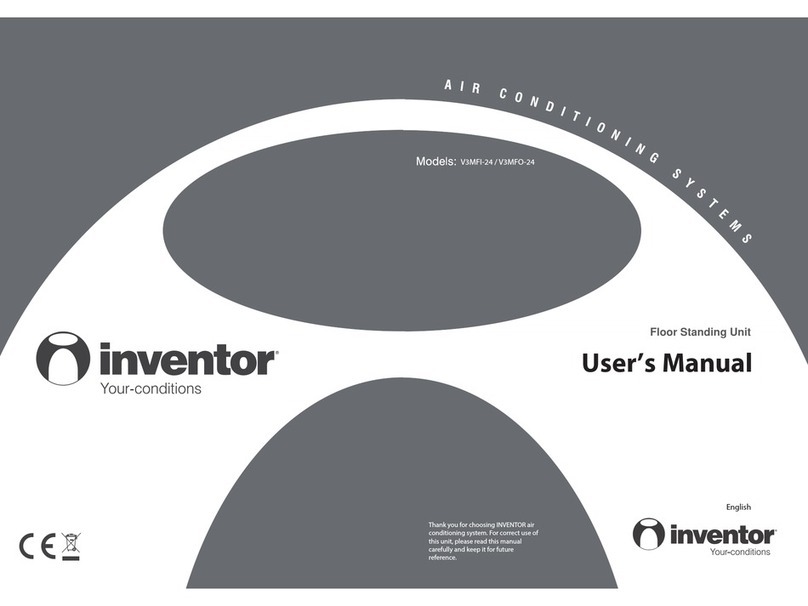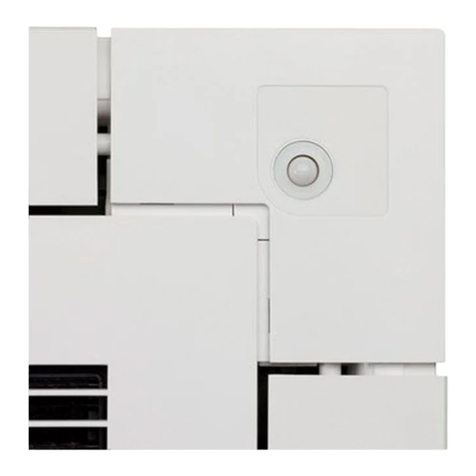EMI KWCA09AO User manual

HIGH WALL COOLING
DUCTLESS
9,000, 12,000, 18(
24,000
...... :ii!¸I:::,I_(:
Enviromaster Internati(
5780 Success Dr,
Rome, NY 13440
www,enviromaster, com

mNSTALLATION, OPERATION AND MAINTENANCE MANUAL
P/N 240006537, Rev. 1.0 [01/07]
This manual is intended as an aid to aqualified service personnel for proper installation,
operation, and maintenance of EMI EnviroAir high efficiency R-410A Ductless Split
Systems. Carefully read these instructions before attempting installation or operation.
Failure to follow these instructions may result in improper installation, operation, or
maintenance, possibly resulting in fire, electrical shock, property damage, personal
injury, or death.
(1) Retain this manual for future reference.
(2) Before leaving the premises, review this
manual to be sure the unit has been
installed correctly and run the unit for
one complete cycle to make sure it
functions properly.
To obtain technical service or warranty
assistance during or after the installation
dthis unit, check our website @ www.
enviromaster.com or call your installing
contractor or distributor. Our technical
service department may be contacted at
1-800-228-9364.
When calling for assistance, please have
the following information ready:
Indoor Unit
Model Number
Indoor Unit
Serial Number
Outdoor Unit
Model Number
Outdoor Unit
Serial Number
Date of installation
Read all instructions before using
the EMI EnviroAir high efficiency
system. Install or locate this sys-
tem only in accordance with these
instructions. Use this system only
for its intended use as described in
this manual.
Check rating plate for correct system
voltage before installing. Installa-
tion and operation of a system with
the incorrect voltage may result in
malfunction or other issues and will
void _he warranty.
The EMI EnviroAir system must
be connected only to a properly
grounded electrical supply. Do not
fail to properly ground this unit.
Turn off the electrical supply be-
fore servicing the EMI EnviroAir
system.
Do not use the EMI EnviroAir
system if it has damaged wiring, is
not working properly, or has been
damaged or dropped.
[Save These/nstrucdons]
X,_ j
This symbol is an indicationof ,_"_
Important Safety Information.

TheEnviroAirsystemisanefficientduct-
lesssplitairconditioningsystemwithcooF
ingcapacitiesfrom9,000-24,000Btuhand
heatpumpcapacityof9,000-24,000Btuh.
Designedforquietoperationandboasting
compactdimensions,theEnviroAirsys-
temincludesadvancedfeatureslikeauto-
restart,fullfeatureremotecontrol.
oMain System Breaker: Sized per unit
requirements, to be mounted adjacent
to outdoor unit.
oMounting Hardware: Wall anchors,
condenser pad.
oVacuum Pump
oGauge Set: R-410 specific.
oHigh Vo#age interconnect Wiling:
14 AWG wiring from outdoor unit to in-
door unit for power and control. *
oRefrigerant :R-410A required for addi-
tional line sets beyond 16 ft=
• Can be purchased through the factory asan
accessory, (partof the Tube Set Kit below)
Comprised of three standard components
the indoor high wall evaporator, the out
door condensing unit, and an infrared
handheld remote contro!. The EnviroAir
system is engineered to the highest per-
formance and reliability standards. The
evaporator is equipped with permanent
washable air filters as well as motorized
air sweep for enhanced air circulation, and
the condensing unit is equipped as stan-
dard with a high efficiency rotary compres-
sor.
Tube-Set Kit consisting of:
oRefrigerant Line Set - 25 feet of
suction and liquid line, both fully in-
sulated, and flare fittings supplied
on both ends.
ointerconnecting High Vo#age Wiring
- 25 feet supplied.
oAdd#ional Condensate Tubing - 6feet
extra supplied.
EMI recommends the EnviroAir system
for residential and light commercial cool-
ing applications. The EnviroAir system will
operate in standard cooling mode down to
60°F outdoor temperature.
oMatched System Consisting Of:
Evaporator section and condenser sec-
tion with remote control.
The EnviroAir system is backed with the
standard limited warranty that applies
to all EMI equipment. For a copy of this
limited warranty, please contact EMI cus-
tomer service or refer to the website at
_,_Nw.enviromaster, com.
Application:
Check the application of the unit prior to
installation, certain applications require
additional components or installation pa-
rameters, such as the need for external
condensate pump or if the system will
need to perform low ambient cooling at
outdoor temperatures below 6O°F.

KWCA09A0
KWCA12A0
KWCA18D0
KWCA24D0
KWHA09A0
KWHA12A0
KWHA18D0
KWHA24D0
K1CA9000A00
K1CA2000A00
K1CA8000D00
K1CA4000D00
K1HA9000A00
K1HA2000A00
K1HA8000D00
K1HA4000D00
Cooling Only
Cooling Only
Cooling Only
Cooling Only
Heat Pump
Heat Pump
Heat Pump
Heat Pump
9,000
12,000
18,000
24,000
9,000
12,000
18,000
24,000
115zlz60
115zl-60
208/230-1-60
208/230-1z60
115-1-60
115-1-60
208/230zl-60
208/230-1-60
Example
EnviroAir Unit
Unit Style
W=High Waft Unit
Duty
C= Cooling Only
H = Heat Pump
Design Revision
A=R-4'10A
Capacity
09 =9,000 Btuh
12 = 12,000 Btuh
18 = I8,000 Btuh
24 = 24,000 Btuh
Voltage
A="115-I-60
(09 and "12only)
D= 208/230-"1-60
(18 and24 only)
Not Used
Example
EnviroAir Unit
Number of Zones
I=Single Zone
Duty
C=Cooling Only
H=Heat Pump
Design Revision
A=R-410A
Zone I Capacity
9= 9,000 Btuh
2 = 12,000 Btuh
8=18,000 Btuh
4= 24,000 Btuh
Not Used
Not Used
Not Used
Voltage
A=115-1-60
(9 and 2only)
D= 208/230-I-60
(8 and 4 only)
Controls
0=Standard
Condenser Coil
0=StandardAI/Cu

Determine the best location for mounting
the indoor unit, it must be located a mini-
mum of 4ft (6 ft or more recomended) from
the floor and no less than 6" from ceiling.
Pay attention to the air circulation in the
room, 9,000 & 12,000 Btuh units throw air
15ft, 18,000 & 24,000 Btuh units throw air
25ft, ensure no obstacles to airflow exist.
Locate the indoor and outdoor units as close
together as possible, maximum line set run
and lift MUST NOT BE EXCEEDED. Deter-
mine how the interconnect piping, wiring
and condensate hose are to be run.
Units are supplied with a wireless remote
control, which communicates with the unit
microprocessor control. The return air
temperature sensor mounted in the in-
door unit provides input to the control for
system operation.
Several modes of operation are available
to the end user depending on the type of
comfort required. All unit operating func-
tions are controlled via the remote con-
trol. Refer to "_System Operation" section
of this manual.
KWCA/K 1CA 09/12
KWCA/K1 CA 18/24
KWHA/K1HA 09/12
KWHA/K1 HA 18/24
35 Feet
50 Feet
35 Feet
50 Feet
17 Feet
17 Feet
17 Feet
17 Feet
Ensure that all panels can be removed for
service as required.
Cerdffeadon:
All EnviroAir Ductless Splits are certified
by UL under UL Standard 1995. Per-
formance is varified by CSA under ARI
210/240 test standard.
Low Ambient Contro#
Please consult the factory for availability of
approved method of low ambient cooling
operation.
Condensate Pump:
It is recommended to use the supplied
condensate drain hose in a gravity fed
method whenever possible. If this can
not be done then a field installed pump
that is external to the evaporator would
be required.

structions,failureto followI
s maycausepossiblemat=I
ndvoidanywarranty. J
J
Remove indoor and outdoor units from
the carton/box, indoor unit carton con-
tains, remote controt and batteries, en-
sure these are kept in a safe place during
installation.
Locate area to install indoor unit the
unit should be located a minimum of 6 ft.
from the floor and 6" from the ceiling.
Choose an area where the watt is plumb
and determine how to best to run the unit
interconnects.
CEIMNG
ceiling minimum
6" from
from wall
minimum
4R from floor (minimum)
6R plus from floor (optimum)
FLOOR
Ensure no obstacles to airflow are directly
in front of the unit, for a minimum of 12 ft
for 9,000/12,000 Btuh units and 16 ft for
18,000t24,000 Btuh units.
Do not install the Indoor unit units in areas
exposed to high humidity (Relative Hu=
midity of 80% or more), direct sunlight and
direct heat from stoves or other devices.

Prepare the evaporator for moundng
by removing the mounting bracket from
the rear of the indoor unit. Use a Phillips
head screwdriver to remove the unit pipe
strap. If the unit is a heat pump the de-
frost sensor also must be undone from its
retainer.
If mounting the unit on an outside wall
measure from the edges of the unit to the
center of the line set 90° bend to locate the
the center of the wall penetration. Drill a
3" e hole through the wall. Angle the wall
penetration slightly down towards the out-
side to assist in draining the condensate
away from the unit.
If mounting the unit on an inside walt, use
the knockouts provided on the left and
right sides dthe unit to route the piping
and wiring connections through.
The indoor unit weighs a maximum of
20 Lbs. Use watt anchors to secure the
mounting bracket to a watt stud and en-
sure that the wall is capable of holding the
weight of the unit.
Be sure mounting bracket is level, so that
the condensate can drain properly.
knockout remove mounting knockout
mounting
bracket
on wall

_are unit fine set connections
Rotate refrigerant line stubs gently to 90°
(if mounting on an outside wall). For oth-
er line set configurations align the stubs
as required.
ieP:Use Duct tape to tape the Con-_
nsate hose (make sure it is below I
Ithe Line set stubs) and the defrost I
I sensor (heat pump only). This makes I
I it easier to guide them through the I
f
i !!!
Feed the 14 AWG interconnect wiring
between indoor and outdoor through
the unit electrical connection (maxi-
mum number of 6 wires is required) (if
required by local codes an electrica/
connector can be attached to the rear
of the unit). Tape the loose wire to the
line set stubs. (See Electrica/Wiring In-
staff section.) These two tips save time
and prevent damage to the stubs when
mounting the indoor unit.
HEAT PUMP SYSTEMS

Install unit on mounting bracket
Feed the line set stubs/condensate hose/
wiring connections through a o 3" hole in
the walt.
Position the evaporator so that the "key"
slots on the back of the unit slide onto the
tabs on top of the mounting bracket. Then
push the lower portion of the evaporator
against the bracket until it latches into the
mounting bracket.
indoor unit is now installed, it should be
ptumb, level and flush with the wait. in-
sure that the line set stubs are completely
through the watt penetration, also check
that the watt is plumb. The unit must be
level and plumb for proper condensate
removal.
Locate Outdoor unit
Select a location with proper ventilation,
minimizing recircutation possibility. Do not
install the outdoor unit in a location ex-
posed to high winds (field fabricated and
installed wind baffle may be required).
Clearances for the Outdoor unit:
Ensure location does not impede access
around unit and pose a disturbance to
neighboring areas.
Install the outdoor unit on a condenser
service pad. If unit is a heat pump ex-
tend feet to raise 6" to allow for defrost
to drain away.
8" Minimum
Ote: Consult factory if"_
inimum clearances can't I
maintained. )
Airflow
40" Minimum
12" Minimum

Re_nt Line Set Pi in
interconnectingline set between the outdoor
unit and the indoor unit, must have both re-
frigerant lines insulated as the expansion
device is located in the outdoor unit.
Gently bend the tine set stubs from the in-
door unit to the desired location. Using 2
x 10"/12" Crescent wrenches remove the
flare nuts from the indoor unit tine stubs.
The indoor unit is filled with a dry gas,
check for retease of this to ensure that no
leaks are present. Use a smatt amount of
vacuum pump oil on the male flare threads
to ease installation.
Outdoor
Unit
Connect the line set to the stubs. Using
the 2 wrenches, 1 on the male and 1 on
the female tighten the flare nuts. Run the
tine set to the outdoor unit, avoid tight
bends and kinking the lines.
If line set length is in excess of that re-
quired, cut line set and re-flare or coil ex-
cess vertically to facilitate oit return to the
compressor
Service port Gas line service vahe
Line set connections
under the GRAY
caps.
set cover
Indoor Unit
Install the line set on the
indoor unit stubs.

Evacuation
Gauges can now be attached to the service
ports - SERVICE PORTS HAVE A 5/16"
CONNECTION TO GAUGES, which is dif-
ferent from the norm for R-22. You will need
specific hoses or an adaptor for the 5/16"
connection.
Once the gauges are attached the line
set can be leak checked using Nitrogen
at 300 psig. Evacuate the unit and inter-
connect down to a minimum of 400-500
Microns, break vacuum with Nitrogen to
further leak check.
Re-evacuate the system down to 300-400
Microns or lower for a period of one hour.
This is an R-410A System it is essential
that a deep vacuum be pulled on the sys-
tem to remove all traces of moisture. See
"System Start-Up" section to fine-tune the
refrigerant charge.
Main Power Wirin_
Electrical wiring should be done in ac-
cordance with all National Electrical Code
(NEC) and local state!city building codes.
_Note: A small screwdriver is required_
Breaker size and wiring must be sized
for the rating plate amperage, MCA and
HACR. Use only HACR type breakers,
each system installed must have a sep-
arate branch circuit with an individual
breaker/fuse.
9,000
2,000
8,000
!4,000
9,000
2,000
8,000
!4,000
115/80/1
115/80/1
220/60/!
208/230/80/!
7,2
9,6
6,4
8,1
7,2
9,6
6,4
8,1
A local disconnect should be installed ad-
jacent to the outdoor unit in accordance
with National and Local Codes. The out-
door unit provides power for the indoor
unit, no disconnect is required between
the outdoor and indoor units.
Line voltage from the disconnect should
be wired to: N - L (115V Unit), + G
LI - L2 (208/230V Unit), + G
Remove right side knockout on the termi-
nal access panel for whip/wiring connec-
tion. Ground connection must be made to
the terminal plate.
Heat Pump (208,/230V) unit terminals:
LI - L2 : Power from breaker + G
L3 - L4 : Power to indoor unit + G
1- 2 - 3 : Control signals
These are just examples of typical wiring
connections. Alway_ refer to Wire Diagram
on unit for actuamwiring connections.
:Foreasieraccessto the terminalsin the_
oorunitremovethe loweraccesspaneltoJ

Electrical Wifin_ installation
Electrical Wiring should be done by a
certified electrician in accordance with
aft National ElectdcaICode (NEC) and
local state!city building codes.
ALL CONTROLS WIRING BETWEEN IN-
DOOR AND OUTDOOR UNIT IS HIGH
VOLTAGE MINIMUM 14 AWG WIRE MUST
BE USED.
outdoor unit must be a point to point i.e.
the terminal that the wire is attached to on
the outdoor unit must be the same termi-
nal it is wired to in on the indoor unit.
Remove terminal covers from indoor unit
and wire to the terminals, (small screw-
driver required). Control wiring from the
Control wiring at outdoor unit (cooling only).
Ground wires connected to the terminal
plate indoor and outdoor units must be
grounded.
Connection of wires for outdoor
unit and indoor unit

If the system is a heat pump the defrost
sensor must be connected from the in-
door unit to the defrost sensor in the out-
door unit. Standard lead length is 25 ft,
if a longer length is required then cut the
lead and extend using thermostat wire.
The heat pump defrost sensor intercon-
nect wire comes bundled up with the indoor
units. It then should be "un-bundled" and
connected to the molex connection at the
indoor unit and run to the outdoor unit motex
connection, typically with the interconnect-
ing wiring andlor interconnecting tubing.
ote: use of colored wire (supplied with_
Illne set) and defrost sensor connected I
(_eatpump only). ....
I_ Defrost Sensor "_
I I
Joor wire connector for deJrostirl"x_ outdoor prob_ wire cor/rlel_
Ground wires connected to the terminal plate on indoor and
outdoor units must be grounded.
Connection of wires for outdoor
unit and indoor unit
f(115V Node[s)
(heating mode0
f- (208/230VNode[s) -_x
unit
Indoor To power
unit , _ _ L_ L_ _/ source
(heating model) j

12) Condensate Hose:
The unit is provided with approximately
18" of condensate hose connected. Hose
connection is sized to accept a 3/4" OD or
5/8" ID clear plastic hose to then extend to
building drain.
There is approximately 6' of additional
drain hose supplied with the (accessory)
line set.
All condensate hose extensions should be
in accordance with local building codes.
Remember water only flows downhill to
ensure positive draining from the unit.
Check using water for a positive flow of
condensate.
The basic system installation is now com-
plete. The unit is now ready for start up.
With the evaporator and line set completely
evacuated the system can now be opened
to allow the refrigerant charge in the out-
door unit to be released into the line set.
The condenser is charged with enough
R410A refrigerant for 16 feet of interconnect.
For longer line set lengths additional charge
must be added in per the following table.
KWHA/K1HA09/12
KWHA/KIHA18/24
_!i!i!i!i!_!_!_iiiii;i,ii_ii,X,ii_iiiiiiiiiii
1.2oz.
2.4oz.
1.2oz.
2.4oz.
The service valves require a 6mm and a
5mm Allen wrench respectively to undo
the valve stems. Remove the brass caps
from the service valves. Open the suc-
tion fine valve first to prevent any pos-
sible oil logging of the capillary tube ex-
pansion device that can occur if the liquid
line valve is opened first with the rest of
the system in a deep vacuum. Then open
the %_quid or Expanded Gas" line.
Unscrew both valve stems until they come
to a stop against the valve body, replace
the brass caps, then tighten the caps to
prevent leaks. Energize the breaker to aF
low system to be powered.
Open the suction fine valve first
Continued next page.

ote: tf interconnect is less then 12_
eta small amount of refrigerant may I
ed to be reclaimed to achieve the I
oper charge for optimal operation. I
viroAir recommends fine tuning us= I
yng the _Superheat" method, j)
Start the indoor unit, cooling mode is
only allowed when the outside ambient
temperature is above 60° F to prevent
damage to the compressor. Unit has a 3
minute time delay before the compressor
start up operation.
The use of the superheat method is highly
recommended for field charging or check-
ing the existing refrigerant charge in a
system that is in the cooling cycle. Because
each installation is different in terms of
indoor airflow, refrigerant line length, etc..,
the factory charge may not be correct
for every application. To assure the best
performance from the air-conditioner, the
refrigerant charge should be checked and
adjusted, if need be, on each installation.
For proper superheat readings, a standard
low=side refrigerant gauge and an accurate
thermometer is needed. A mercury or
stem=type thermometer is not adequate
for suction=line temperatures. We recom=
mend electric thermocouple thermometers
(available at most refrigeration wholesaF
ers); however an accurate remote=bulb
thermometer can be used. When measur=
ing the line temperature, be sure the theF
mometer is securely attached to assure
accurate measurements. The chart below
gives superheat values at various outdoor
temperatures. Allow at least 5 minutes run=
ning time between charge adjustments for
the unit to stabilize.
S$UPIERHEAT CHARGmhlGCHART
Chart based on 360 to 400 CFM/ton indoor air flow and 66% relative humidity
Use on systems that cool with capillary or piston
5,0 '_ In :loot d,ybulb tempe, ature
450 95_ _ _ _._.
55 60 65 70 75 80 85 90 95 100 105 110 115
',-. OUTDOOR TEMPERATURE °F j

Instrucdons:
1. Measure suction pressure and deter-
mine evaporator-refrigerant temperature
on R410A scale of low-side gauge.
2. Measure suctionqine temperature on
suction line of the unit.
3. Measure outdoor and indoor tempera-
tures.
4. Determine from the table what the
superheat should be for the indoor and
outdoor temperatures.
5. Adjust charge if needed. Be sure unit is
running at stabilized condition.
Example of typical system operations:
80°F DBi50% RH Indoors
82°F DB Outdoors
140 (49 ° F Saturated Temperature)
Refer to supplied superheat chart (16° F)
70° F Indoors
Note:
47° F Outdoors
350/375 (107/112 ° F Saturated Temperature)
10-15° F
When the system is in heat cycle, the refriger-
ant charge is checked by using the liquid sub-
cool method. Liquid sub-cool is the temperature
below the high side pressure at its saturation
temperature.

Guide to features and their function
There are many models, features and appearance will vary. The figure shown is
representative of the operation of 9,000/12,000 Btuh systems.
Ak return grill ]
Takesinthe indoorair
A_etnl÷t
a__de_ & ea_ su_a_e
Pushdowntheair inletgrilleandthepushbothsidesofak inlet
grilleatthebottom.
Lightlypushbothsidesofthe airinletgr!lieatthe
bottonandpullittothissidetilla resistanceisfelt ]'i_s b $u/'_cs_ be $_das a_ ;me_f}e[_cymeas re,to _tmoni_b_
_¢_ whe_ _ote co_'o,l_eris _oi avai_sbk_
_Note; Do not open the grille atan angle over 60 degrees.

Remote Contro| Operation
(:SETTEMPERATUREbutto_
/o
ON!OFF button )
Thisbutton,when pressed,startsoperation
andstops whenpressedagain
FAN
SWING button

Remote Centre| Operation
_._. Note: Wait 3 minutes before restarting the unit. b
Selecting MODE of OPERATION
To select operating mode, point the remote control
toward the indoor air conditioning unit:
1) Press the ON/OFF @ button to START.
2) Press the MODE O button to step through the
operating modes:
_' AUTO MODE - automatically operates the sys-
tem in DRY, COOL ,or HEAT mode depending on
the indoor temperature and setting.
COOL MODE - operates the system in COOL
mode depending on the indoor temperature and set
point.
(,/,_>DRY MODE - operates the system in DEHUMIDF
FICATION mode.
s2,, HEAT MODE - operates the system in HEAT
mode depending on the indoor temperature and set
point.
/_lmportant:
Heating operation will cease at approximately I
15 F outdoor temperature due to a sensor Io- I
cated in the outdoor unit. This product does not I
contain supplemental electric heat, therefore I
other means of heat need to used when this sys- I
Jem ceases operation at low outdoor ambients.J
_FAN MODE - runs the FAN to circulate the air.
3) Press the ON/OFF button again to STOR

Remote Centre| Operation
_erature _'uetment in AUTO SELECT mode
To adjust the air temperature during AUTO SELECT
mode, point the remote control toward the indoor air
conditioning unit:
1) Press the _ button once. To raise the set point
temperature 1°C or 1°F.
2) Press the button once, to reduce the set
point temperature 1°C or 1°F.
COOL/HEAT & FAN/DRY mode
Point the remote control toward the indoor air condition-
ing unit:
1) Press the ON/OFF @ button.
2) Press the MODE O button, select the mode of
operation; COOL, DRY, HEAT/FAN or AUTO.
3) Press the
perature.
I 64OF°88OF
(!6°Co31°C)
set the desired tem-
64OFo88OF
(!6°Co3!°C)
Once minimum or maximum setting is reached
operation will be continued by
pressing or
4) Press the FAN SPEED O button to set the de-
sired air flow rate.
Press the ON/OFF 4&_ button again to stop.
SNores:
_ in the COOLING-ONLY operation, the HEAT I
mode wifl disable, and it will go to FAN mode. |
|
|o The settings can be changed even while the air I
This manual suits for next models
23
Table of contents
Other EMI Air Conditioner manuals
Popular Air Conditioner manuals by other brands

intensity
intensity IDUFCI60KC-3 installation manual

Mitsubishi Electric
Mitsubishi Electric MSZ-LN18VG2W operating instructions
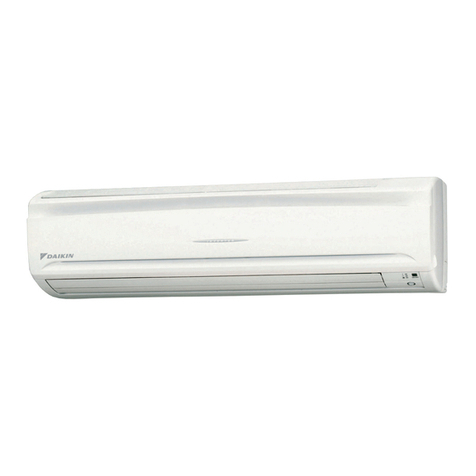
Daikin
Daikin FTXS50EV1B installation manual

Mitsubishi Electric
Mitsubishi Electric Mr.SLIM MS24WN Service manual
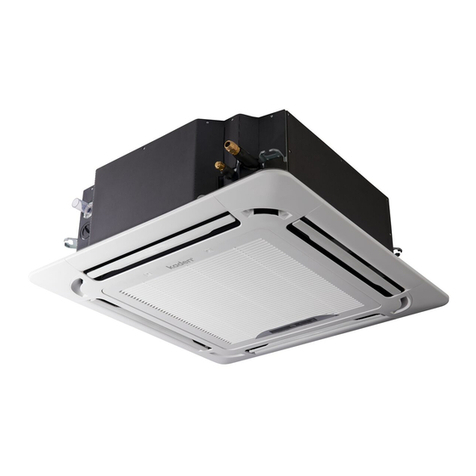
Kaden
Kaden KCS Series manual

Mitsubishi Electric
Mitsubishi Electric MSZ-DM25VA operating instructions
